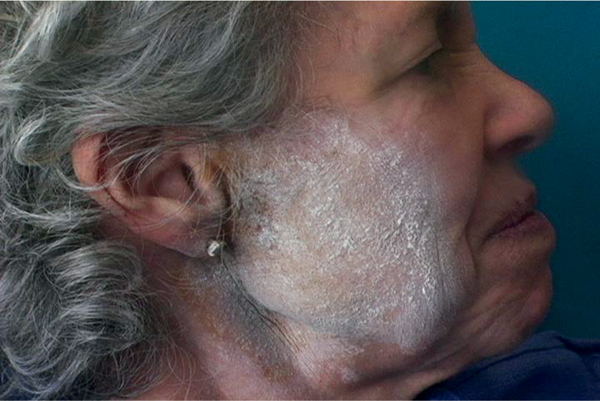17

Frey’s Syndrome
Frey’s syndrome, also referred to as auriculotemporal syndrome or gustatory sweating, is a condition characterized by excessive facial sweating stimulated by the thought, sight, or consumption of food. This unusual syndrome was first described in 1923 by neurologist Lucja Frey1 after she observed a young man whose face had been slashed with a knife subsequently develop gustatory sweating. This phenomenon frequently occurs after surgery or trauma to the parotid gland, facial nerve, submandibular gland, or thoracic sympathetic chain. It is also associated with polyneuropathies, such as those associated with diabetes mellitus, which result in inappropriate parasympathetic cholinergic innervation of cutaneous sympathetic receptors.2,3 The characteristic sweating results from activation of the eccrine sweat glands located in the facial area, as a result of inappropriate cholinergic stimulus from the parasympathetic fibers of the auriculotemporal branch of the trigeminal nerve.
The incidence of Frey’s syndrome after parotid surgery has been reported to be as high as 100% if tested by Minor’s starch-iodine test, but only 15 to 30% of the patients consider their symptoms severe enough to report them to a physician.4
Numerous medical and surgical treatments have been proposed to prevent or treat this condition. Medical treatments4–15 include the application of atropine or scopolamine hydrobromide ointment before meals,4 and topical use of aluminum chloride in alcohol solution.16 Preventive methods at the time of initial surgery have included sternomastoid muscle flap, inclusion of the superficial musculoaponeurotic system in the flap, dermis-fat grafts, expanded polytef and temporoparietal facial flaps,17–21 surgery to raise a flap and place fascia beneath the skin to prevent further reinnervation, and neurectomy (tympanic plexus, Jacobsons’s nerve, chorda tympani nerve, auriculotemporal nerve).4–7,22 Overall, the results have been unsatisfactory. Botulinum neurotoxin injection of the affected skin is now a first-line treatment modality for Frey’s syndrome.
Intracutaneous injections of botulinum neurotoxin (Botox) have been used successfully in the management of hyperhidrosis.23 In 1994, Drobik and Laskawi24–26 first reported the use of botulinum neurotoxin (BoNT) to treat gustatory sweating with local intracutaneous injections. In a later update,27 they reported their 3-year observation of a group of 19 patients, demonstrating the mean duration of the treatment to be 17.3 months. Since that first 1994 report, more groups have reported their experience using the same method, yielding positive long-standing results. For instance, we have reported our experience with seven postparotidectomy and posttrauma patients treated with BoNT/A.28 Likewise, Restivo et al29 reported the effective use of the same method in 14 diabetic patients. Other, more recent reports, have shown promising results, including those from Pomprasit and Chintrakarn30 assessing nine postparotidectomy patients, from Martos Diaz describing 10 patients, and from Luna-Ortiz et al31 reporting 23 patients who were clinically assessed for severity of symptoms based on the extent of the affected area, excessive focal sweating, and unpleasant-smelling sweat. Furthermore, Cantarella et al32 recently presented positive results from their experience with seven patients treated with BoNT/B. In most of these cases, the patients were given a dosage of BoNT/A ranging from 1.5 to 2.5 units (U) per cc, or 80 U of BoNT/B, which yielded significant improvement of the symptoms. The majority of patients were symptom free for 6 to 12 months. After that time period, some patients experienced recurrent gustatory sweating, albeit it a decreased amount compared with that before the treatment. In those cases of recurrent Frey’s syndrome, a second injection was necessary after 12 to 18 months. Most patients were permanently free of symptoms after a second or a third injection.
 Workup
Workup
In most cases, conservative treatment has failed before patients are referred for BoNT treatment. Each patient should be counseled regarding the risks and benefits of, and alternatives to, BoNT treatment, and should sign a detailed informed consent form, which explains that BoNT injection for gustatory sweating is an “off-label” use of an approved medication.
After a careful history and physical examination, Minor’s starch-iodine test is performed as follows: the patient’s lateral face is painted with an iodine solution, which is then allowed to dry. Once dry, the area is dusted with starch powder. The patient is then given a sialogogue (lemon juice, grapefruit juice, etc.) to stimulate salivation. The starch turns blue-black in the area where the moisture is produced (Fig. 17.1).
Stay updated, free articles. Join our Telegram channel

Full access? Get Clinical Tree



